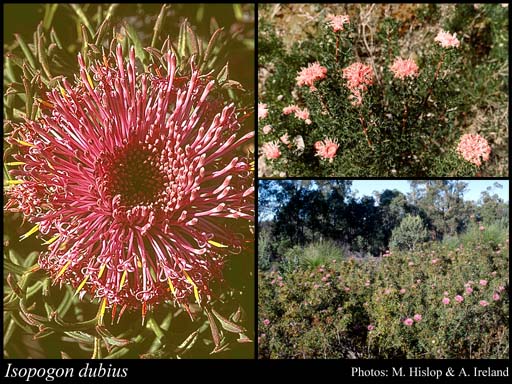- Reference
- Rep.Bot.Exch.Club Brit.Isles 4:629 (1917)
- Conservation Code
- Not threatened
- Naturalised Status
- Native to Western Australia
- Name Status
- Current
Compact, bushy shrub, 0.3-1.5 m high. Fl. pink/pink-red, Jul to Oct. Sand, sandy loam, clayey soils, lateritic sandy gravel.

Scientific Description
Shrubs, 0.5-1.5 m high; branchlets hairy, with curled hairs. Leaves alternate, 25-55 mm long, hairy; lamina flat, twice or more divided, pinnately divided or tripartitely divided, entire or divided to the midrib, with 6-9(-15) points or lobes; distance from base of leaf to lowest lobe 15-30 mm. Inflorescences not viscid, pink. Perianth 20-31 mm long, hairy, the limb apex hairy at the apex only; pistil 20-31 mm long; pollen presenter not fusiform, glabrous, 4-5.2 mm long, the brush 1.5-2 mm long. Cone with deciduous scales, 25-30 mm long. Flowers in July, August, September or October. Occurs in the South-west (SW) Botanical Province(s), in the Geraldton Sandplains (GS), Swan Coastal Plain (SWA), Avon Wheatbelt (AW) or Jarrah Forest (JF) IBRA subregion(s).
Distribution
- IBRA Regions
- Avon Wheatbelt, Geraldton Sandplains, Jarrah Forest, Swan Coastal Plain.
- IBRA Subregions
- Dandaragan Plateau, Katanning, Lesueur Sandplain, Northern Jarrah Forest, Perth, Southern Jarrah Forest.
- Local Government Areas (LGAs)
- Armadale, Beverley, Boddington, Carnamah, Chittering, Coorow, Cuballing, Dandaragan, Gingin, Goomalling, Gosnells, Kalamunda, Moora, Mundaring, Narrogin, Perth, Pingelly, Swan, Three Springs, Toodyay, Victoria Plains, Wagin, Wandering, West Arthur, Williams, Wongan-Ballidu, York.